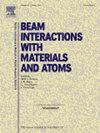A new map-polynomial fitting extrapolation method of data in the low scattering vector region for dilute polydisperse spherical systems in SAXS
IF 1.4
3区 物理与天体物理
Q3 INSTRUMENTS & INSTRUMENTATION
Nuclear Instruments & Methods in Physics Research Section B-beam Interactions With Materials and Atoms
Pub Date : 2025-02-01
DOI:10.1016/j.nimb.2024.165606
引用次数: 0
Abstract
Dilute polydisperse system is a common research object in small angle X-ray scattering (SAXS). In SAXS studies, the extrapolation of the scattering data in the low scattering vector region is necessary for many quantitative structural analyses. The classical Guinier extrapolation method is based on the Guinier approximation, which is only applicable to the scattering data with a distinct linear segment on the Guinier plot. In this contribution, a new map-polynomial fitting extrapolation method is proposed. It takes the bilateral data constructed by mapping the measured data as the fitting object, and provides reliable extrapolation results within an explicit fitting range and a specific polynomial order. The new method is superior to the Guinier method in terms of extrapolation effect and applicability range. The feasibility of the proposed method is verified by experimental sample.
SAXS中稀多分散球形系统低散射矢量区数据的映射-多项式拟合外推新方法
稀多分散体系是小角x射线散射(SAXS)中常见的研究对象。在SAXS研究中,低散射矢量区散射数据的外推是许多定量结构分析所必需的。经典的Guinier外推方法基于Guinier近似,仅适用于在Guinier图上具有明显线性段的散射数据。本文提出了一种新的映射多项式拟合外推方法。它以实测数据映射构造的双边数据作为拟合对象,在明确的拟合范围和特定的多项式阶内提供可靠的外推结果。新方法在外推效果和适用范围上均优于Guinier方法。通过实验验证了该方法的可行性。
本文章由计算机程序翻译,如有差异,请以英文原文为准。
求助全文
约1分钟内获得全文
求助全文
来源期刊
CiteScore
2.80
自引率
7.70%
发文量
231
审稿时长
1.9 months
期刊介绍:
Section B of Nuclear Instruments and Methods in Physics Research covers all aspects of the interaction of energetic beams with atoms, molecules and aggregate forms of matter. This includes ion beam analysis and ion beam modification of materials as well as basic data of importance for these studies. Topics of general interest include: atomic collisions in solids, particle channelling, all aspects of collision cascades, the modification of materials by energetic beams, ion implantation, irradiation - induced changes in materials, the physics and chemistry of beam interactions and the analysis of materials by all forms of energetic radiation. Modification by ion, laser and electron beams for the study of electronic materials, metals, ceramics, insulators, polymers and other important and new materials systems are included. Related studies, such as the application of ion beam analysis to biological, archaeological and geological samples as well as applications to solve problems in planetary science are also welcome. Energetic beams of interest include atomic and molecular ions, neutrons, positrons and muons, plasmas directed at surfaces, electron and photon beams, including laser treated surfaces and studies of solids by photon radiation from rotating anodes, synchrotrons, etc. In addition, the interaction between various forms of radiation and radiation-induced deposition processes are relevant.

 求助内容:
求助内容: 应助结果提醒方式:
应助结果提醒方式:


